First of all I must admit that I am far from being an expert on the following topics, and definitely I do not want to offend anybody with what will come next. I really liked travelling through the Black Continent and especially West-Africa is an area where I want to come back again in future. Yet it is surely true that when discovering these countries – in my opinion – there are not so many historical sites to see as in other regions like South-America, China or India. In fact, Africa’s history comes down mostly to early tribes and former regional powers, then colonialism and independence and afterwards today’s political, economic and social situation. Often the current societies lack a bit of an own characteristic past determining their proper culture and distinguishing them from their neighbors. Of course, there are a few exceptions and luckily Benin is one of them.
Around 1625, one of the chiefs of the numerous principalities in nowadays’ Benin settled in Abomey, conquered the neighboring kingdoms and founded the Dahomey Dynasty. For almost three centuries, Dahomey was one of the most important forces in West-Africa and the European colonial powers (mainly Portugal and France) fearfully had to reckon with this fierce empire. They rather avoided the capital city of Abomey and built-up the slave-trade ports of Ouidah and Porto Novo. Having its peak in the 19th century, approximately ten thousands slaves per year were shipped to Brazil and the Caribbean. The Dahomeyan Kings actively took part in this flourishing market and grew rich by selling countrymen to traders. They exchanged them primarily against canons and guns and used those weapons to pillage the surrounding areas for extending their land and acquiring new slaves again. At the very beginning of the 20th century, the French eventually colonized the Kingdom of Dahomey and forced the ultimate King Béhanzin to sign a treaty, which gave the French full administrative power over the former empire and led to the formation of the Protectorate of Dahomey. Béhanzin was sent away into exile and the colonial period lasted until Benin’s independence in 1960.
Since my arrival in Benin, I have visited the historical places of Abomey and Ouidah (and I will also go to the Portuguese-founded capital Porto Novo after a short stopover in the country’s economic center Cotonou). Although being a rather quiet town now, in Abomey you can still feel the importance and influence of the Dahomeyan Dynasty. Each of the kings had his own palaces and voodoo temples and you can see and visit many of them. I was especially impressed by the size of the structures – the biggest palace has a 4 km long and 10 m high wall enclosing a court which used to house 10000 people. Inside, lots of artifacts and relics are exhibited and give you an idea of the rulers’ quite bloody behavior: there are courtyards where up to 200 wives lived, ceremonial rooms for human sacrifice, burial chambers and a throne mounted on the skulls of some enemies. Outside, the stunning bas-relief on the walls illustrate both the glory of Dahomey and the mystic force of animist fetishes, and they were a major reason to classify the whole structures as UNESCO World Heritage Site. Unfortunately you are not allowed to take pictures.
A totally distinct experience is Ouidah, which from the 17th century on was among the most important slave-trade ports at the Gulf of Guinea. The museums inside the forts built by the French and above all the Portuguese show the impact slave-trade had on the local population, the devastating effects caused by the inhuman conditions and the resulting links between Benin’s tradition and the Brazilian and Caribbean cultures. Most impressive was following the “Route des Esclaves”, a 4 km long trail from the town’s center to the beach. It retraces the different steps the slaves had to undergo until finally leaving their motherland forever. Once sold at the auction square, they made their way down to the coast where they boarded the ships to the Americas, being crammed together worse than animals. During the way, they had to endure several “ceremonies” which were meant to destroy them mentally while testing their physical strength. They always walked in chains, they had to circle a holy tree to enter into a state of trance and forget the land they were about to leave, and they had to stay one week in a completely dark room in order to hamper any kind of rebellion. All those who were not strong enough were thrown and buried into a mass grave.
At the end of the route, a poignant memorial named “Point de Non-Retour” (“Point of No Return”) stands on the shore to the sea. Its beauty deliberately and consciously contrasts to the fact that 12 million persons were deported from that place. I went down the trail accompanied with a friendly and competent guide, who knew and explained a lot about the history of slaves in West-Africa. It was stunning to listen to a genuine opinion which is shared by most locals here: even though the slave-trade massively increased with the arrival of the Europeans (to some smaller extent the Dahomeyans had already started this practice before), they do not deny or neglect that also a considerable amount of Africans were involved in this market and took the advantage of this opportunity to enrich themselves. To them, this is the real tragedy that has to be put forward. “The hyena has eaten its own children” is a common phrase you often hear. And similar to what we do in Europe regarding historical tragedies, they have learnt and are ready to forgive but they do not forget and keep the memory of the victims alive, however without any bitterness of revengeful feelings.
Travelling through Benin to these destinations is a bit adventurous. We had complained about Tanzania’s not-perfectly-working bus system, here I realized that at least they do have one. In West-Africa, the only mean of transport are shared-taxis, but before you think of a comfortable, independent and luxurious way to get around, I have to stop you and correct your image. If you are interested in running your own shared-taxi service, here is what you have to do: you get a car from a European junkyard with not less than 25 years of age and 300 thousands kilometers. If it has 5 seats, you put AT LEAST 3 persons in front (including the driver) and 4 on the back row. You additionally load up with tons of luggage, merchandise and animals (once I travelled with chickens inside the car and pigs and a motorbike on top of the roof). Then you drive off and pray that locals will inexplicably complain that “y’a pas le goudron” – paved roads are in such a bad shape that you need to avoid big holes all the time. On a trip we needed 4 hours for 100 km, so I still prefer the indeed dusty and sandy roads in Tanzania because nevertheless they are flat and you can smoothly roll over them. Of course, you stop every 10 minutes to empty and refill your tank again and earn some money thanks to fuel smuggling. If you manage to survive the crazy truck drivers and other insane traffic participants and reach your final destination unharmed and unhurt, you can jump onto a “zem” who will try to bring you to your hotel in one piece by zigzagging via overcrowded streets and while talking on his phone.
The reward of such exhausting journeys are the warmhearted people you meet during the pauses. Even if I do not like the term so much (Africa has so many facets and much more to offer), maybe the remote and undeveloped villages of Benin’s countryside are the actual “Real Africa” we had not found in Zambia. The inhabitants live of simple agriculture and sell you extremely cheap food. White men are literally non-existent so you are always the superstar. At the beginning they are a bit shy and have a weird look at you, but when they realize that apart the color of your skin you are of the same human sort, they will be interested in speaking with you, proud to welcome you at their shop and children are so happy if you shake their hands or wave back. Nearly never they beg for money or try to overcharge you, this just happens in bigger cities. I have spent a great part of the journey with Greg, a nice chap from England and the first other white person I met here. He is on a seven months trip from the north-west to the south-east of the continent and has a good bunch of stories to tell. Without knowing French, he started in Morocco and travelled through Mauritania and Senegal to lawless Guinea (where he had scary hassles with corrupt soldiers at border-crossings in the middle of nowhere), he then worked as volunteer in Ghana and continued his way to Togo and Benin, afterwards he will visit Uganda and Tanzania before making another voluntary job in Malawi …. respect, dude!
This time, I will conclude and finish with a small quiz question: what is a “poulet bicyclette” or “bicycle chicken”, a cheaper option (compared to a normal one) you can order in a few “maquis”-restaurants when you want to eat poultry?

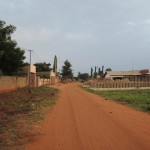
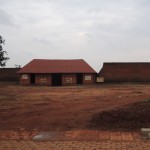
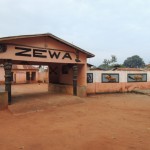
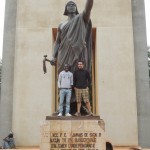
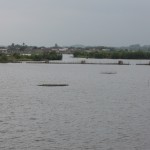
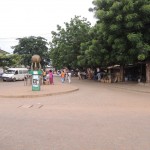
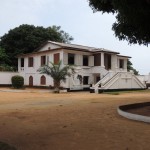
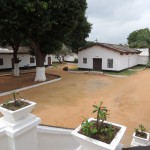
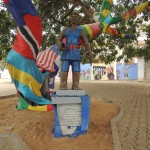
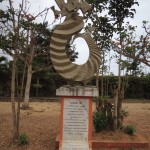
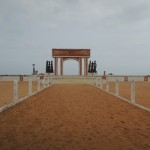
L’histoire du taxi me rappelle Bilbao. Certes la voiture n’était pas très remplie, mais JAMAIS une telle voiture aurait pu faire le taxi en Allemagne !